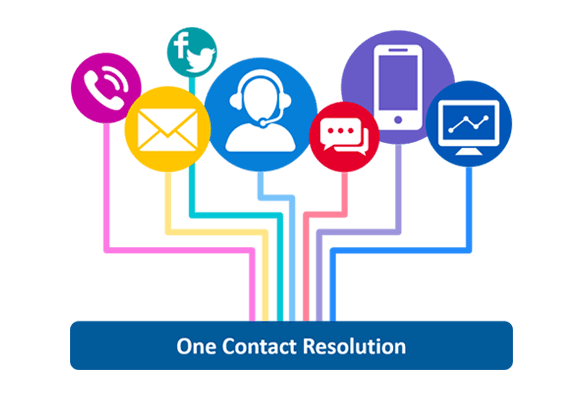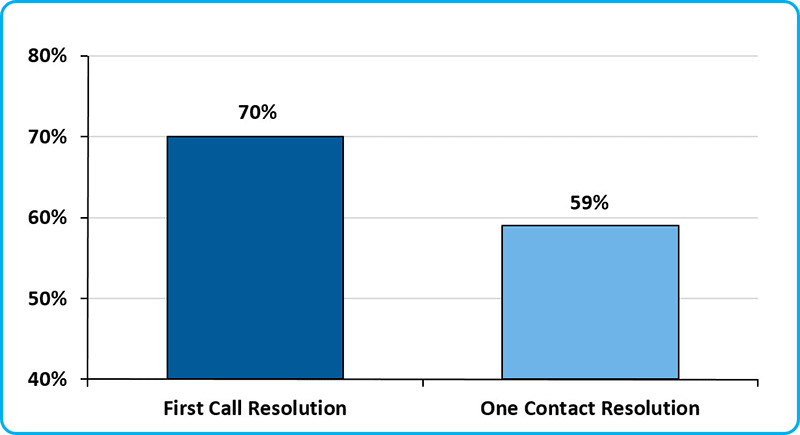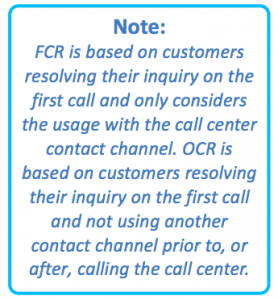
One Contact Resolution
The Metric that Matters the Most for Improving Multi-Channel Customer Experience
The vast majority of SQM client senior executives would agree that delivering a world class customer experience for contact channel usage is critical to their organization's success. Many North American C-level leaders seek to improve customer experience, and in many cases, it is the number one priority for their organization.
Based on measures our clients use for determining their customer experience success and SQM's research on the impact of those measures on organizations' performance, the business case for improving contact channel customer experience for resolving an inquiry or problem is as follows:
Improve Customer Satisfaction (Csat) – When the same contact channel is used, Csat (top box response) drops by 15% for each customer's additional contact to resolve their inquiry or problem. However, when a customer has to use multiple contact channels to resolve their initial inquiry or problem, Csat drops, on average, by 19% for each additional contact channel used.
Customers want to be able to choose their contact channel and to resolve their inquiry or problem on the first contact channel they used. Given that at least 20% of customers use two or more contact channels to resolve the same inquiry or problem, improving One Contact Resolution (OCR) represents a considerable opportunity for contact centers to improve customer experience.
The easier it is for a customer to resolve their inquiry or problem, the higher the Csat. That is why the OCR customer experience has the highest Csat (89%) by far of all the contact channel experiences (i.e., OCR, omni-channel, and multi-channel) a customer has for resolving an inquiry or problem.
Reduce Customers Defections – If the contact was unresolved, 23% of customers expressed their intent not to continue using the organization's products and services because of their contact channel experience. The cost of customer defections due to their contact channel experience tends not to be understood by contact centers because it is not often measured.
Retaining customers represents the most significant opportunity to add true value to their organization for many contact centers. Resolving contacts, preferably on the first contact, on any contact channel used is the key to reducing customer defections. Only 5% of customers who have their contact resolved on the first contact expressed their intent not to continue using the organization's products and services due to their contact channel experience.
Given the considerable impact a customer's contact channel experience has on customer satisfaction and retention, organizations must invest in measuring the customer's experience when using a contact channel or multiple contact channels to resolve an inquiry or problem. Measuring OCR will help ensure an organization's success in improving customer experience and reduce customer defections.
Introducing One Contact Resolution Metric
SQM is proud to introduce the new One Contact Resolution (OCR) metric. OCR is based on customers resolving their inquiry on the first call and not using another contact channel before or after calling the contact center. In a typical contact center, on average, they are responsible for six or more contact channels. However, 20% of customers who used a call center also used another contact channel trying to resolve the same inquiry or problem. OCR will become the metric that matters the most for improving customer experience in the new multi-channel world.
Most contact centers are completely unaware of how many customers try to resolve their inquiry or problem before or after calling the call center using other contact channels. Also, they are not aware of the negative impact of two or more contact channels on customer satisfaction and retention. Since so many customers are using self-service and the call center to resolve the same inquiry and problem, contact centers should measure both FCR and OCR metrics.
Figure 1 shows the difference between First Call Resolution (FCR) and OCR performance when a call center was one of the contact channels used. The data reveals that OCR is 11% lower than FCR. The reason for this difference is because OCR factors in the customer being able to resolve their inquiry on the first call and not having to use another contact channel before or after calling the call center.
For the average call center, an alarming 41% of customers cannot resolve their inquiry or problem on the first contact. Given that only 59% of customers have an OCR experience, it should be viewed as a huge wake-up call for the contact center industry to start measuring the customer's entire experience (i.e., all contact channels used) when trying to resolve the same inquiry or problem.
Figure 1: First call resolution and one contact resolution metrics difference

 SQM truly believes that of all the contact center metrics, FCR and OCR are the metrics that matter the most, which is why SQM focuses on both FCR and OCR. These metrics drive world class customer satisfaction and retention.
SQM truly believes that of all the contact center metrics, FCR and OCR are the metrics that matter the most, which is why SQM focuses on both FCR and OCR. These metrics drive world class customer satisfaction and retention.
The FCR metric should not be confused with the OCR metric. Again, FCR is based on customers resolving their inquiry on the first call and considers only the usage with the call center contact channel; FCR does not take into consideration whether or not other contact channels were used. On the other hand, although OCR is also based on customers resolving their inquiry on the first call, it does factor in whether or not other contact channels were used.
In short, the distinction between FCR and OCR is that FCR only considers the usage in an individual contact channel, and OCR factors in all contact channels used for resolving an inquiry or problem.
Most contact center managers tend to struggle with defining and measuring FCR and OCR. The most common reason for this struggle is that contact centers do not clearly define FCR or OCR. Also, they do not effectively measure these two metrics from the organization's or the customer's point of view.
Internal FCR and OCR measurement methods, such as QA and FCR callback technology, may be used and can be good practices. However, these methods are not a best practice for defining and measuring FCR and OCR because they are not VoC FCR or OCR.
Internal FCR and OCR measurements overinflate performance by 10% to 20% for the average contact center because they do not factor in customers who do not call back or customers who use another contact channel. In addition, OCR is more difficult to measure because it requires an understanding of whether or not the customer used more than one contact channel to resolve their inquiry or problem.
Internal FCR and OCR measurement methods should be viewed as supplements to VoC FCR and OCR measurement methods. The best practice for defining and calculating FCR and OCR is to let the customer be the judge of whether or not their inquiry or problem was resolved and how many contacts and channels were required.
After all, as the old saying goes, the VoC opinion of their experience matters the most. VoC FCR and OCR measurements are based on using post-contact customer survey methods such as phone, IVR, email, and website. With that in mind, the following are VoC FCR and OCR definitions and measurement calculations.
OCR (One Contact Resolution) Definition: OCR is defined as the percentage of customers who resolved their inquiry or problem on their first call and did not use another contact channel before or after using the call center. VoC OCR is based on the survey results.
OCR Calculation: The calculation of VoC OCR is based on the number of surveyed customers who determined their inquiry or problem was resolved on the first contact using only one contact channel, divided by the total number of surveyed customers.
OCR Calculation Example: Based on survey results, the number of surveyed customers who determined their inquiry or problem was resolved on the first contact using only one contact channel (236) ÷ the total number of surveyed customers (400) = 59% OCR performance level.
Quick Related Links
First Call Resolution Definition First Call Resolution PPT First Call Resolution Benefits
First Call Resolution Strategies First Call Resolution Operating Philosophy First Call Resolution Formula Contact Channels What is a good FCR Rate? Channel Hopping Top 10 Contact Channel CX Metrics
